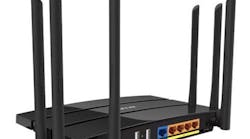A few months ago, I was happy to install a brand new 802.11ac router in my home. If you’re not already judging me for just now getting 802.11ac, you may very well judge me for having my cable company install the router instead of installing it myself.
The IEEE 802.11ac standard introduces unprecedented “theoretical” data rates that are literally an order of magnitude improvement over 802.11n technology. In my case, the term “theoretical” is important, because my local cable provider isn’t exactly known for delivering the highest quality of service. In fact, as a resident of Austin, Texas, I pray daily that Google Fiber arrives quickly.
This file type includes high resolution graphics and schematics when applicable.
As seemingly recent as 802.11ac is, it’s hard to believe that the IEEE working group is closing in on even more recent 802.11 revisions. Because these newest revisions aren’t solving the exact same use case as Wi-Fi, it’s worth spending some time to explain how both the use case and physical layer is different from the 802.11 revisions used in Wi-Fi. More specifically, we’ll investigate what’s new with 802.11ad, 802.11af, and 802.11ah.
As an aside, I won’t be discussing what’s new with 802.11ag, because it doesn’t exist. Many of today’s Wi-Fi products support 802.11a and 802.11g, and because many of these are often referred to as having 802.11a/g support, the 802.11 working group skipped 802.11ag to avoid confusion.
802.11ad
Of the three standards, 802.11ad technology is easily the furthest along, with products already on the shelf and the standard (802.11ad-2012) already published. Many of us know this technology as “Wi-Gig”—remember that the Wi-Gig Alliance merged with the Wi-Fi Alliance in 2013. Many expect the Wi-Fi Alliance to begin formally certifying Wi-Gig products in 2016.
Given the signal-propagation challenges at 60 GHz, some of the first applications for 802.11ad are those that require high data rates over short distances. In fact, the first examples include wireless docking stations and wireless 4k video transmissions.
The 802.11ad standard uses the unlicensed bands around 60 GHz in addition to a 2.16-GHz channel bandwidth. The wide channel bandwidths—combined with modulation schemes up to 64-QAM—deliver nearly 7 Gb/s over a single stream. Although the standard does not support multiple spatial streams, Wi-Gig products utilize multiple antennas in a beamforming use case to offset the high path loss at 60 GHz.
802.11af
IEEE 802.11af-2013 is another interesting standard from the IEEE working group. It was designed to use TV white spaces from 54 to 790 MHz (depending on geography). Mobile carriers have long eyed the TV white spaces for cellular communications due to the advantages of excellent signal propagation in those frequencies. At present, 802.11af routers, billed as “outdoor Wi-Fi,” are just beginning to enter the market in Asia.
Given that 802.11af transmissions will use bandwidth once occupied by broadcast TV channels, the standard allows for 6-, 7-, and 8-MHz transmissions—an equivalent bandwidth to broadcast TV (bandwidth varies by geography). In addition, the standard allows for modulation schemes up to 256-QAM, supporting multiple spatial streams and channel bonding (carrier aggregation). Transmissions are capable of 35.6 Mb/s in an 8-MHz channel in a single stream, and will scale upward depending on the number of bonded channels and spatial streams.
802.11ah
One of the most promising and broadly appealing standards of the group is IEEE 802.11ah, which is designed to use the ISM (Industrial, Scientific, and Medical) bands around 900 MHz and support channels ranging from 1 to 16 MHz in bandwidth. Modulation schemes range from BPSK to 256-QAM, with data rates up to 150 kb/s in 1 MHz of bandwidth. The standard is currently in draft, with an expected release in early 2016.
Many industry pundits believe 802.11ah is the primary wireless technology that will one day connect tomorrow’s devices—enabling the Internet of Things. Although it might be too soon to tell, one of the biggest reasons why 802.11ah is likely to succeed is its widespread support from some of the industry’s largest chipset vendors.
The need for 802.11ah certainly isn’t for lack of alternatives, especially as ZigBee (900 MHz and 2.4 GHz) and Bluetooth Low Energy (2.4 GHz) offer low-energy transmissions in ISM bands. However, history has shown that politics more often than technical merit determines which standard wins in the long run. For that reason, with the right marketing push behind it, 802.11ah is likely to catch on.
Implications on Test Equipment
Whether life after 802.11ac involves ad, af, or ah, one thing is clear: The best way to future-proof your test equipment is to use a software-defined approach. To a software-defined instrument, the waveforms and measurements brought by each new standard aren’t terribly different from the last. However, each of these standards could potentially bring mainstream 802.11 technology to new bands ranging from 54 MHz to 60 GHz.
For the engineers working on 802.11ad, specifications such as 2.16 GHz of signal bandwidth at 60 GHz are currently beyond the reach of today’s RF vector signal generators and analyzers (although Moore’s law is helping instruments catch up). For 802.11af and ah, the existence of broadband vector signal generators makes testing these devices much more feasible. Assuming your test system uses broadband (versus banded) signal generators and analyzers, updating your test system to test af and ah devices should be as simple as a software upgrade.
This file type includes high resolution graphics and schematics when applicable.
It is difficult to know exactly what tomorrow’s world of wireless technologies will bring. However, what we do know is that they are changing the economics of wireless test—for the chipset as well as the wireless device. For both, the future ushers in greater device complexity and lower price targets. As a result, engineers are tasked with drastically lowering their cost of test. Given these factors, the wireless test market is ripe for innovation.



